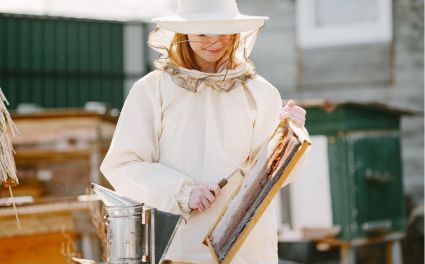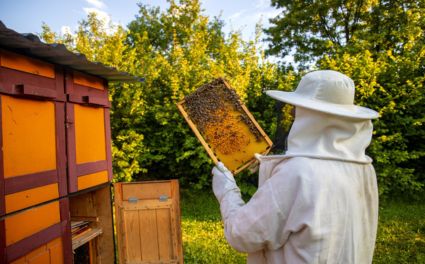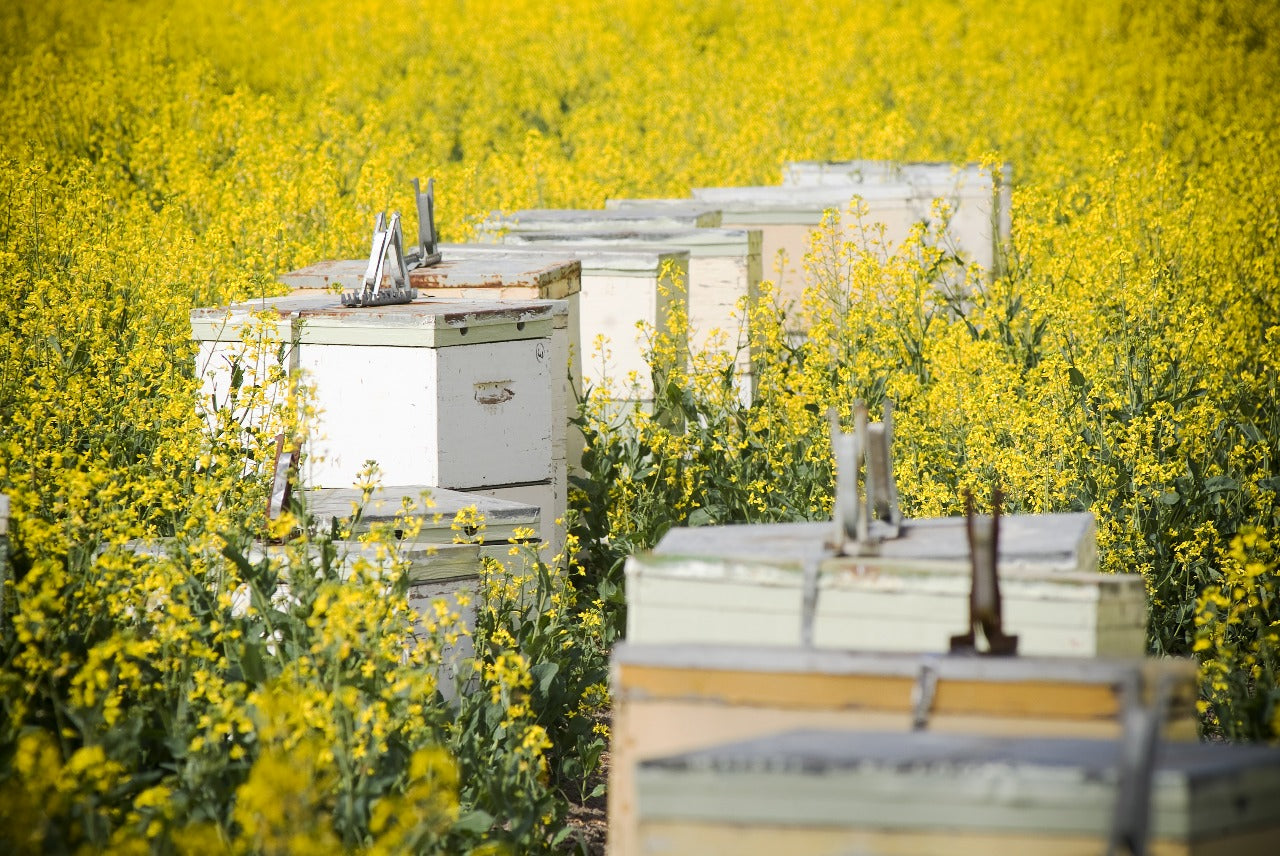Bees are important pollinators in the ecosystem. They have a unique reproductive process that is vital for the survival of their colonies. Bees have a fascinating reproductive journey, with different stages in their life cycle and specific roles within the hive.
This showcases the complexity of their social structure and the importance of maintaining a delicate balance in their ecosystem. Studying bee reproduction helps us understand how environmental factors, colony dynamics, and fundamental processes work together to ensure the survival and growth of these important insect species.
The Bee Life Cycle
The life cycle of bees consists of four important stages that are necessary for their growth and survival. The egg stage is the beginning of the bee's life cycle. During this stage, the queen bee lays eggs in hexagonal cells within the honeycomb. These eggs are small, white, and oval-shaped. They have the potential to help the colony grow.
Next, after the eggs hatch, they undergo a larval stage, where they turn into larvae that resemble legless grubs. During this phase, nurse bees carefully nourish the larvae with a mixture of pollen and honey known as "bee bread," which helps them grow quickly.
The larvae eat a lot and go through several molts before becoming pupae. The larvae create a cocoon around themselves and go through a remarkable transformation inside.
Finally, the adult bee stage emerges, completing the complex process of metamorphosis. Fully developed bees in a colony have specific roles that are important for the survival and productivity of the colony.
Reproductive Roles in a Bee Colony
Queen Bee
The queen bee is the most important member of the colony. She is responsible for keeping the hive running smoothly and making sure it continues to thrive. Her main job is to lay eggs and keep the colony's population stable. She uses pheromonal communication to control the behavior and activities of the worker bees, promoting unity and organization in the hive.
The queen bee has impressive reproductive abilities. She can lay up to 1,500 eggs every day. This impressive accomplishment helps the colony grow and stay healthy. It makes her an important part of the bee reproductive process.
Also read: How does a bee become queen?
Worker Bees
Worker bees make up the majority of the colony and perform important tasks that are necessary for the hive to function properly. The worker bees have several important tasks. They take care of the young bees, gather nectar and pollen, construct and upkeep the hive, and defend it against any dangers from the outside.
Worker bees have limited ability to reproduce, even though they play a crucial role in the hive. Their main focus is on tasks that are important for the survival and well-being of the colony rather than tasks related to reproduction. These tasks contribute to the overall welfare of the colony as a whole rather than focusing on individual reproduction.
Drone Bees
Drone bees are bigger and have a unique appearance compared to other bees in the colony. The main purpose of male ants is to mate with virgin queens from different colonies. This helps to increase the genetic diversity within the species. The number of drones in a hive is usually smaller than the number of worker bees.
Drone bees have an important role in bee reproduction. They help maintain genetic diversity in the colony and the overall bee species. After completing their reproductive role, bees are usually removed from the hive. This highlights their important and specific function in the overall reproductive process of the bee colony.
Mating Process of Bees
The queen bee's mating flight is an important part of her reproductive cycle. During this event, the queen bee leaves the hive to find places where drones gather. After finding these areas, she performs aerial dances and releases pheromones to attract male drones. The queen bee needs to mate during this flight to ensure she can reproduce throughout her life. This is important because it allows her to fertilize the eggs she lays in the colony.
Also read: How do bees collect honey?
Mating Congregation Areas for Drones
Male bees, called drones, gather in specific places called drone congregation areas. These areas are usually located away from the hive. Here, bees wait for signals from the queen bee and mate with her while flying. Congregation areas are important for maintaining genetic diversity and ensuring the survival of the species. They allow different colonies to exchange genetic material.
Mechanism of Fertilization in Bees
Bees undergo fertilization when the male bee, called a drone, transfers sperm to the female bee, known as the queen bee, during mating. The queen bee keeps the sperm she collects in a special organ called the spermatheca. This allows her to fertilize eggs for the rest of her life. The queen bee lays eggs and uses stored sperm to fertilize them. This helps maintain genetic diversity and keeps the colony healthy. The process of fertilization in bees helps create genetic diversity and adaptability in their colonies, which is important for their resilience and survival.
Nesting and Brood Development
The queen bee's mating flight is an important part of her reproductive cycle. During this event, the queen bee leaves the hive to find places where drones gather. After finding these areas, she performs aerial dances and releases pheromones to attract male drones. The queen bee needs to successfully mate during this flight in order to be able to reproduce throughout her life. This is important because it ensures that the eggs she lays in the colony will be fertilized.
Mating Congregation Areas for Drones
Male bees, called drones, gather in specific places called drone congregation areas. These areas are usually located away from the hive. Here, bees wait for the queen's pheromonal cues and mate with her while flying in the air. Congregation areas are important for the genetic diversity and survival of species. They help different colonies exchange genetic material.
Also read: How is bee pollen made?
Mechanism of Fertilization in Bees
Bees fertilize eggs when the male bee transfers sperm to the female bee during mating. The queen bee keeps the sperm she collects in a special organ called the spermatheca. This allows her to fertilize eggs for her entire life. The queen bee lays eggs and uses stored sperm to fertilize them, which helps maintain genetic diversity and colony health. The process of fertilization in bees helps create genetic diversity and adaptability in their colonies, which helps them survive and thrive.
Factors Affecting Bee Reproduction
Temperature and climate changes have a big impact on bee reproduction. Bees, including queen bees, need specific temperature conditions for eggs to develop successfully. Extreme temperatures or sudden climate changes can harm the hive by disturbing the delicate balance. This can affect the development of the brood and ultimately impact the overall population of the colony.
Urbanization and agricultural expansion are causing habitat loss, which is a direct threat to bee populations. Destroying natural habitats decreases the amount of food and places for bees to build nests, which makes it harder for them to reproduce successfully. The use of pesticides in modern agriculture is a big problem for bees. These chemicals can harm the bees' ability to reproduce and can make their colonies unhealthy.
Colony Health and Genetic Diversity
The health of a bee colony, which includes disease resistance and nutrition, has a big impact on bee reproduction. Colony health can be negatively affected by mite infestations, viral infections, or inadequate nutrition. These factors can result in reduced ability to reproduce and weaker offspring. Genetic diversity is important for keeping bee populations strong and adaptable.
When genetic diversity is reduced, colonies become more vulnerable to diseases and environmental stress. This can have negative effects on their ability to reproduce and survive in the long run. Beekeepers and conservationists can help preserve bees by maintaining a healthy and diverse bee population. This supports sustainable bee reproduction, which is important for the survival of these essential pollinators.
Also read: How to safely remove a bee stinger?
Challenges and Conservation Efforts
Bees around the world face many challenges that put their survival at risk. Some factors that contribute to the decline of certain species are habitat loss, exposure to pesticides, climate change, and the spread of diseases and parasites. Bees are important pollinators that help maintain biodiversity and ensure food security. The decline of bees is a significant concern for ecosystems and agricultural productivity.
Importance of Bee Conservation
Conserving bees is crucial for keeping the environment in balance and ensuring there is enough food for everyone worldwide. Bees are important pollinators that help many plants, including crops we eat, reproduce. Protecting bee populations is important for maintaining the balance of natural ecosystems and agricultural systems. This is beneficial for the environment and also for human well-being.
Strategies for Promoting Bee Reproduction and Survival
Creating bee-friendly environments involves:
- Planting a variety of flowers that bees are attracted to.
- Offering appropriate places for them to build nests.
- Reducing the use of pesticides.
Creating landscapes that are friendly to pollinators, such as bees, not only helps their populations but also promotes a healthier ecosystem.
Public awareness and education campaigns are important for promoting understanding and support for bee conservation. By educating communities about the important role of bees in the ecosystem and sharing ways individuals can help protect them, we can inspire people to take action and make behavior changes that contribute to preserving bee populations.
Communities and policymakers can collaborate to address challenges faced by bees and implement effective conservation strategies. This will help ensure the survival and prosperity of these important pollinators.
Final Thoughts
In conclusion, the reproductive mechanisms of bees are not only vital for their survival but also for the sustenance of entire ecosystems. Successful bee reproduction relies on a delicate balance between environmental factors, colony dynamics, and the roles of different bee castes. It is important to protect and support bee populations by conserving their habitats and educating the public. This helps ensure that pollination can occur and biodiversity can be maintained worldwide. Understanding bee reproduction helps us better appreciate its importance in the ecosystem. Bees play a vital role in the web of life on Earth.












